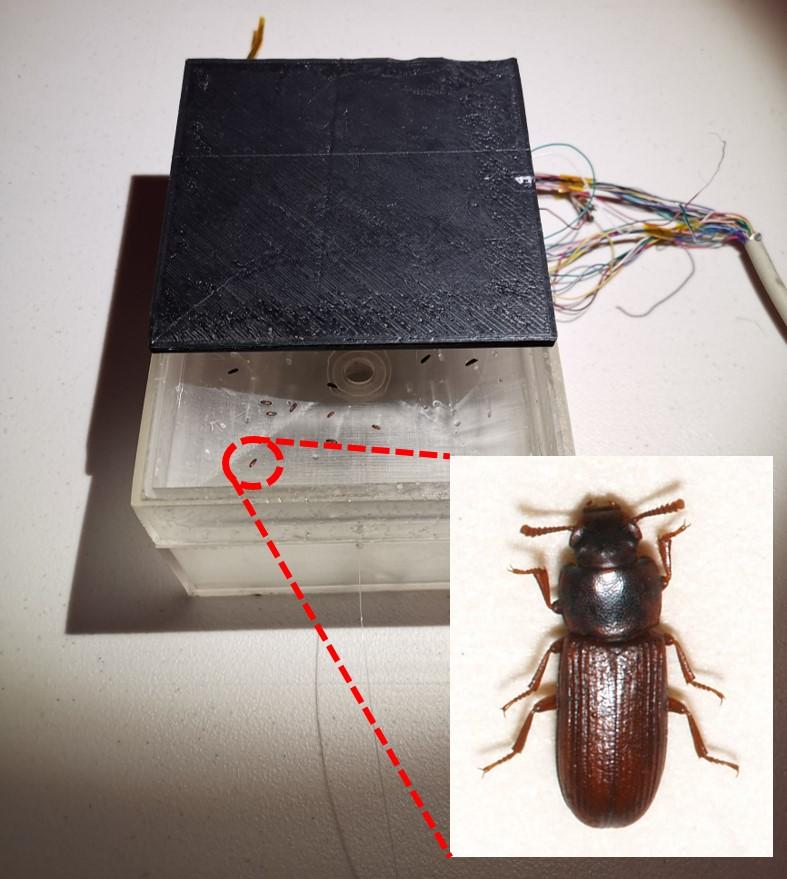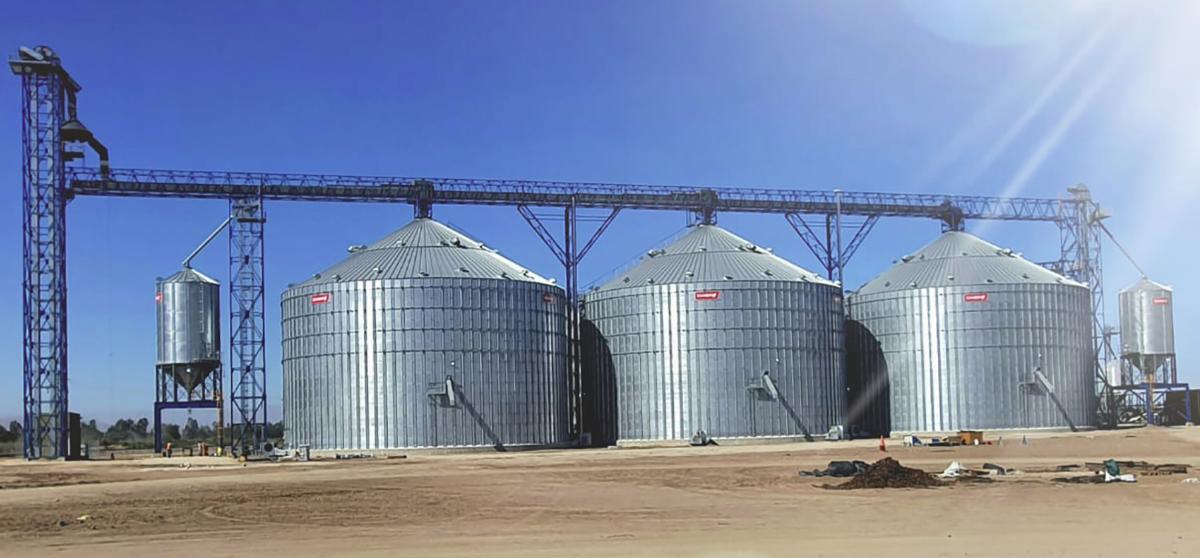
By 2050 the United Nations says food producers will need to produce 60 percent more food to feed a world population estimated to reach 9.3 billion.
Smart agriculture will help farmers meet this necessary goal by leveraging advanced technology to take the industry into the future. The enhanced tools will increase the quality and quantity of their yield, while also improving efficiency, safety, and sustainability.
Researchers at the Georgia Tech School of Computer and Electrical Engineering (ECE) are leading the way in smart agriculture innovation. With research in many areas of smart ag, that include livestock, horticulture, and crop storage, ECE is helping to create the next generation of farming technology.
Pheromone Detection Breakthrough for Crop Protection
Bugs and other pests are a big problem for agriculture, with 20 to 40 percent of global crop production lost to them each year, according to the United States Department of Agriculture (USDA).
“Typically, the way to check for these pests is to actually send someone to check on crops periodically, but sometimes it can be too late,” Professor Manos (Emmanouil) Tentzeris said.
Tentzeris, the head of ATHENA group - whose work among other things, focuses on novel SmartAg - is one of the several ECE researchers working on remote sensing devices that will help mitigate this loss and protect crops.
He, along with ECE senior research scientist Yunnan Fang, recently published a study covering an ATHENA-developed new ultra-low-cost film sensor fabricated by an inkjet printer that for the first time ever can detect pheromones in the air from nearby invasive and harmful pests in real-time.
The proof-of-concept research focused on the detection of flour beetles, but the films that detect the pheromones can be easily customized for a number of harmful insects as reported in an upcoming publication IEEE Electronic Components and Technology Conference 2024 publication, which demonstrates pheromone detection for silk moths.
When a pheromone is picked up by the film, a change occurs in the electrical current inside the sensor, giving the user an immediate warning that insects could be nearby, allowing for dramatically quicker preventative action by farmers well-before an infestation takes place.
Currently, the range of the credit card-sized sensor is five to 10 meters, but the technology allows for that to be greatly increased to cover larger areas.

A flour beetle on the novel sensor developed by Tentzeris and the ATHENA Group.
Enhancements in Air Quality Monitoring
Ammonia and other volatile organic compounds (VOCs) in the air can cause major problems for crops and health issues in animal farming. Along with inadequate humidity and temperature levels, these problems can result in a reduction of crop yields.
The use of low-cost wireless ammonia sensors is crucial for healthy and sustainable animal farming. Professor Farrokh Ayazi is working on a sensor platform technology to address this need. His team developed a sensitive silicon-based resonant sensor that can act as a low-cost, portable air quality detection system.
“Existing ammonia sensors are large and costly to be employed as distributed networks and difficult to collect data from," Ayazi said. "There is a need for low-cost sensor microsystems that provide accurate information on a range of important gases, including ammonia and VOCs, while providing wireless connectivity.”
Due to inefficient design and materials, current air quality sensors have only been effective in detecting VOCs when they are well-above the acceptable level, leading to delayed and potentially ineffective action from food producers.
Ayazi’s design uses silicon-based micro-resonators, offering several benefits including robustness, wide dynamic range, high sensitivity and array implementation. Furthermore, these devices can be integrated with complementary metal-oxide-semiconductor integrated circuits (IC) to develop smart wireless sensing microsystems.
Prototypes of these devices are available at Ayazi’s Integrated MEMS Laboratory.
Translating Chickens
The clucking of chickens is one of the most recognizable sounds on a farm. Professor David Anderson has worked extensively to see if those clucks mean anything.
Chickens are one of Georgia’s most important agricultural products, accounting for what the USDA estimates to be nearly $28 billion in statewide economic impact. But stressful conditions can hurt the growth of chickens during their development, which can then decrease their value when they go to market.

Determining if there’s a meaning behind a flock’s noises can go a long way to detecting subpar living conditions, and ultimately the health and value of chickens.
Along with collaborators from the University of Georgia, Anderson and Wayne Daley from Georgia Tech Research Institute’s Agricultural Technology Research Program (GTRI ATRP), recorded and analyzed chicken noises under normal and stressful conditions.
Machine learning algorithms would then be applied to compare and analyze different aspects of the control and treatment recording to identify different audio features that could have potential meaning.
The research has been used to establish AudioT, a venture that has received support from the Foundation for Food & Agriculture Research, McDonald’s, and Tyson Foods.
Imaging Innovations to Advance Grain Storage Monitoring
Grain storage is critical in reducing food waste, with improper storage potentially leading to severe insect and mold problems that can significantly contribute to global food loss.
The Food and Agriculture Organization of the United Nations estimates around 14 percent of food produced is lost between harvest and retail.
Many times, these problems go unnoticed until the grain is removed from storage, with pesticide treatment coming afterwards, further risking food quality and the health of consumers.
Early detection of pests and mold can greatly reduce the loss of food and help food producers to identify vulnerabilities in their storage procedures. This would greatly help efforts to fight food insecurity, a problem the USDA spent nearly $183 billion on in 2022.
Professor Xiaoli Ma is researching a low-cost multispectral radio-frequency (RF) based tomographic imaging (RFTI) system that she hopes can help solve that problem.
The device uses 3D imaging, spatial data, and machine learning to create reliable images of grain storage facilities, including warehouses, silos, and bins. This helps to detect the presence of pests and pest damage early by tracking abnormalities in the generated images.

Grain storage facilities (Photo courtesy of Sukup)
“Our design is non-invasive and will be also compatible to the current Wi-Fi and cellular networks so that it will be easy to install,” Ma said.
The system will be easy to use and install, as well as inexpensive, as it designed with commercially-available reusable off-the-shelf RF components. Continued research will ensure the technology becomes commonplace on farms around the world.
Related Content
ECE Ph.D. Candidate Returning to Alaska to Continue Transformative Atmospheric Research
Jeremiah Lightner is making his third trip to Alaska, continuing his atmospheric research that will help his group create the first accurate top-to-bottom model of the ionosphere.
From Smart Farming to Delivery Drones, Fall Capstone Design Expo Highlights Student Innovation
Electrical and computer engineering students addressed real world problems with their novel project designs during this semester’s Fall Capstone Design Expo. “Big Hero 6” team tied for Best Overall Project and “FRMBX” won Best ECE Team.

